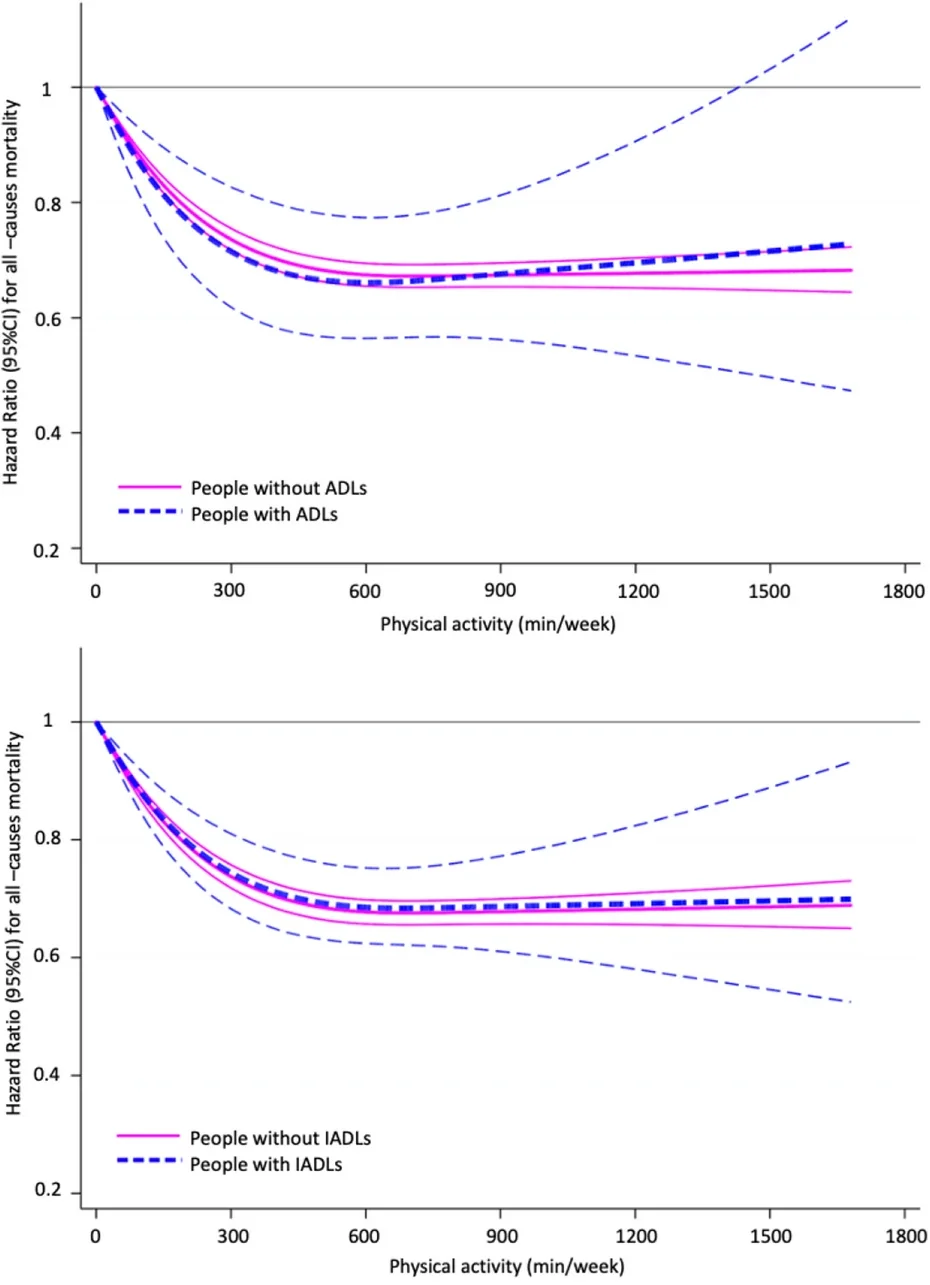Today in GeroScience, researchers have published an analysis of a cohort study, concluding that adherence to physical activity recommendations can mitigate the increased mortality associated with disability.
Simply being able to live
In this paper, disability refers to impediments to the basic activities of daily living (ADLs), such as moving, dressing, showering, and eating. Disability is strongly linked to mortality, as has been shown by longitudinal studies around the world [1, 2, 3]. Older people who are unable to take care of themselves are statistically much more likely to die than their more able-bodied, but same-aged, counterparts.
Some previous work has found that regular physical activity, as expected, mitigates some of the mortality associated with disability [3] as well as mortality among older people as a whole [4]. This has led to the institution of physical activity guidelines by governments and medical establishments [5]. With a very large cohort study as its backing, these researchers endeavored to determine the extent to which adherence to these guidelines is associated with reduced mortality.
An enormous cohort
After exclusions for incomplete data, this study used data from 177,360 people in the United States who were at least 60 years old and were examined between 1997 to 2018. This data was gathered from the National Health Information Survey, and the questions are publicly available online. Respondents who needed help to do very basic tasks were listed as disabled in ADLs, and respondents who needed help to do more advanced tasks, such as shopping and chores, were listed as being disabled in instrumental activities of daily living (IADLs).
Physical activity was measured as being both moderate or vigorous, and these researchers counted vigorous physical activity to count for twice as much. A total of 150 minutes per week of physical activity is recommended by the World Health Organization (WHO).
An extensive amount of other supporting data was included, including demographic characteristics, educational attainment, smoking, alcohol consumption, and body mass. Physician-diagnosed conditions were recorded, and respondents were also asked for their functional limitations.
Expected connections
5.5% of the respondents had disabiliies in ADLs, and 11.7% of the respondents had disabilities in IADLs. As expected, most demographic factors that are associated with mortality, along with functional limitations and chronic disorders, were associated with disability. However, there were some exceptions; for example, women, who live longer than men on average, reported being more commonly disabled.
The average follow-up of this cohort was 8 years, and during that time, 66,694 of the participants had died. 22,673 had died of cardiovascular diseases, and 13,845 had died of cancer. Disability in ADLs or IADLs was associated with a 47%-49% increased risk of all-cause mortality, a 33%-41% increased risk of death from cardiovascular diseases, and an 18%-33% increased risk of fatal cancer.
Physical activity appeared to substantially help with the increased all-cause mortality risk for disability in both ADLs and IADLs, bottoming out at approximately 300 to 400 minutes per week of physical activity.

While the cancer-related results were less consistent, cardiovascular mortality dropped linearly with increased physical activity, and that particular relationship was slightly stronger for people with disability than without it, suggesting that such a regimen may partially make up for the inability to do regular daily tasks that require motion. Even with physical activity, disabled people still had higher mortality risks than people without it.
Limitations and conclusions
This is an association study, not a clinical trial, and it relies on self-reported measurements. Disabled people are, as expected, less likely to follow WHO physical activity guidelines than able-bodied people. There was also no measurement of sedentary behavior.
Ultimately, these researchers believe that interventions on behalf of these older people are required to both improve their survival and their quality of life. Finding environmental and social ways to encourage older people to be more mobile, whether they are disabled or not, is highly likely to be beneficial.
Literature
[1] Yang, Y., Du, Z., Liu, Y., Lao, J., Sun, X., & Tang, F. (2021). Disability and the risk of subsequent mortality in elderly: a 12-year longitudinal population-based study. BMC geriatrics, 21(1), 1-9.
[2] Wu, L. W., Chen, W. L., Peng, T. C., Chiang, S. T., Yang, H. F., Sun, Y. S., … & Kao, T. W. (2016). All-cause mortality risk in elderly individuals with disabilities: a retrospective observational study. BMJ open, 6(9).
[3] Martinez-Gomez, D., Guallar-Castillon, P., Higueras-Fresnillo, S., Garcia-Esquinas, E., Lopez-Garcia, E., Bandinelli, S., & Rodríguez-Artalejo, F. (2018). Physical activity attenuates total and cardiovascular mortality associated with physical disability: a national cohort of older adults. The Journals of Gerontology: Series A, 73(2), 240-247.
[4] Ekelund, U., Tarp, J., Fagerland, M. W., Johannessen, J. S., Hansen, B. H., Jefferis, B. J., … & Lee, I. M. (2020). Joint associations of accelerometer-measured physical activity and sedentary time with all-cause mortality: a harmonised meta-analysis in more than 44 000 middle-aged and older individuals. British journal of sports medicine, 54(24), 1499-1506.
[5] Piercy, K. L., Troiano, R. P., Ballard, R. M., Carlson, S. A., Fulton, J. E., Galuska, D. A., … & Olson, R. D. (2018). The physical activity guidelines for Americans. Jama, 320(19), 2020-2028.




